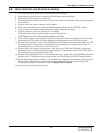
Initial Start-Up and Electrical Checks
19
6.0 INITIAL START-UP AND ELECTRICAL CHECKS
1. Verify that the input and output circuit breakers are off (open).
2. During initial system checks, disconnect all loads (open load disconnects).
3. Inspect all wiring, cables, and connection.
4. If external battery cabinets are used, verify that the battery interconnect cables are fully inserted
in the sockets.
5. Turn on (close) the battery cabinet circuit breaker.
6. On the power distribution box, place the Manual Bypass Switch in the UTILITY position.
7. Turn on (close) the branch circuit disconnect to apply voltage to the input.
8. Using a voltmeter, verify the expected L1-L2 voltage.
Verify the same voltage is measured at the output receptacles.
The BYPASS lamp by the Manual Bypass Switch will light.
9. After verifying proper input voltage to the UPS, turn on the Input circuit breaker located on the
distribution box. The green AC Input indicator should illuminate on the UPS’ front panel.
10. Press the On button for 1 second. The BYPASS lamp will light for several seconds before the UPS
ON lamp turns on continuously. If the batteries are determined to be charged above 80%, an
automatic battery test will run for about 15 seconds.
11. Turn on (close) the output circuit breaker on the rear of the UPS. The UPS lamp on the power
distribution box by the Manual Bypass Switch will light. Transfer the switch to the UPS position.
The output will now be powered by the UPS.
12. Perform a Manual Battery Test - Press the ON button for 1 second. The front BATTERY lamp will
light for about 15 seconds and then return to only the UPS ON and AC INPUT lamps being on.
13. Review all setting options provided by the configuration program. Some changes require that the
UPS be Off. If this is the case, these should be programmed before powering the loads. The
configuration program is described in 7.0 - Configuration Program.
14. Connect all loads for normal operation.
DISCONTINUED
PRODUCT


















